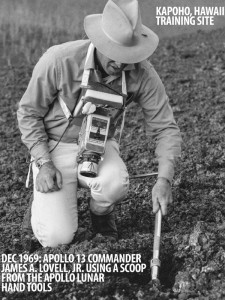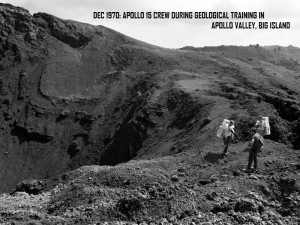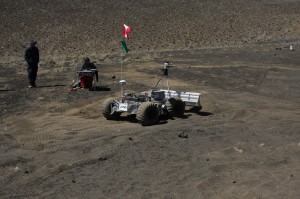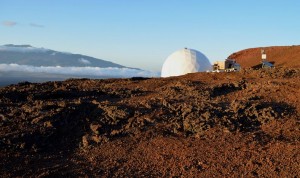Big Island’s Role in Apollo Missions Remembered
Hawaii’s role in the momentous first landing on the moon has been recognized by state lawmakers, and in photographs taken decades ago.
July 20 marks the 45th anniversary of the historic 1969 landing of the Apollo 11 lunar module on what would become known as Tranquility Base, for its location in the moon’s Sea of Tranquility.
That “sea” is actually a broad flow of basalt lava.
So it was only logical that scientists with NASA would look for a similar landscape to train astronauts for that and subsequent Apollo missions, and the Big Island’s volcanic terrain turned out to be ideal.
From 1965 to 1972, that training was carried out in nine locations, including the Hualalai, Mauna Kea and Mauna Loa volcanoes. A variety of craters of Kilauea were also used, including Halema`um`u and Kilauea Iki at the volcano’s summit; the nearby Aloi, Alae and Mauna Ulu craters; and at the northeast rift eruption site at Kapoho.

Apollo 13 Commander James A. Lovell uses a scoop from lunar hand tools in Kapoho in December 1969. NASA photo.
That training deemed essential by NASA, and other Hawaii roles in Apollo missions, are detailed in Senate Concurrent Resolution 82, which was passed during the past legislative session.
The resolution, which designates July 20, 2014 as “Tranquility Base Day” in Hawaii, was prepared with the assistance of the Hilo-based Pacific International Space Center for Exploration Systems, better known as PISCES.
To help commemorate the event, PISCES Executive Director Rob Kelso also obtained archival images from NASA’s Johnson Space Center of the astronauts training on the Big Island.
The resolution notes that Kauai’s Kokee Tracking Station relayed voice and telemetry data between the Apollo 11 astronauts and Mission Control in Houston, Texas.
Moon-walkers Neil Armstrong and Edwin “Buzz” Aldrin Jr. and Columbia command module pilot Michael Collins, along with 47.5 pounds of lunar material, splashed down on July 24, 1969 about 900 miles southwest of Honolulu.

Apollo 15 team members train on a Big Island lava flow dubbed “Apollo Valley” in December 1970. NASA photo.
They were picked up by the crew of the aircraft carrier USS Hornet and placed in a mobile quarantine module – a converted Airstream travel trailer — where they would spend the next five days during transport to Pearl Harbor and then to Hickam Air Force Base.
But the Big Island’s role in space exploration didn’t end with the Apollo missions.
Beginning in the mid-1990s, NASA scientists studying satellite imagery found that deposits of a deeply weathered type of volcano ash called palagonitized tephra found on Mauna Kea resembled material on Mars.
Closer examination found that the ash matched the characteristics of the Martian material better than any other found on Earth.
Hand-quarrying of the ash was carried out on several occasions to provide NASA with material to test space suits and other equipment expected to be needed for a Mars mission.

A rover used to create landing sites is tested on the slopes of Mauna Kea. NASA/Amber Philman photo.
Beginning in 2010, prototype Mars rovers were brought to the slopes of Mauna Kea for on-site testing.
And the training continues today with the Hawaii Space Exploration Analog and Simulation, a program carried out by NASA and supported by PISCES.
HI-SEAS takes place inside a solar-powered dome at the 8,000-foot elevation of Mauna Loa where volunteers experimented first with food and now with ways social interaction and group dynamics affect people in confined spaces.

















